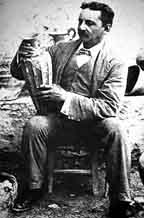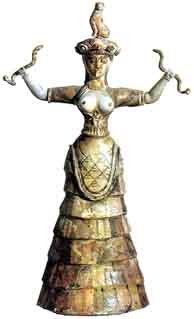Women in the Aegean
Minoan Snake Goddess
Christopher L. C. E. Witcombe
1. DISCOVERY
The faïence figurine identified as a "Snake Goddess"
was discovered in 1903 by the British archaeologist Arthur Evans (Sir Arthur Evans after 1911) in the so-called Temple Repositiories on the site of the "palace" of Knossos on the Aegean Island of Crete.

Sir Arthur Evans (1851-1941)
Evans first published the figurine as part of a report of his excavations in the Annual of the British School in Athens in 1904 [see BIBLIOGRAPHY]. However, it was not until after the publication of the first volume of Evans' The Palace of Minos in 1921 [see BIBLIOGRAPHY], in which much of the earlier report is repeated, that the "Snake Goddess" came to wider attention. The figurine has since acquired canonical status in art history books, and stands out in our minds as an object central to our understanding of Minoan culture.
Besides the "Snake Goddess", numerous other items were also excavated at the same spot, including the figure called by Evans the "votary".
2. The Votary
|

Minoan Snake Goddess
from Knossos, Crete
c. 1600 BCE
faïence
height 131/2 inches (34.3 cm)
(Archeological Museum, Herakleion)
Copyright © (text only) 2000
Christopher L. C. E. Witcombe
All rights reserved
|

